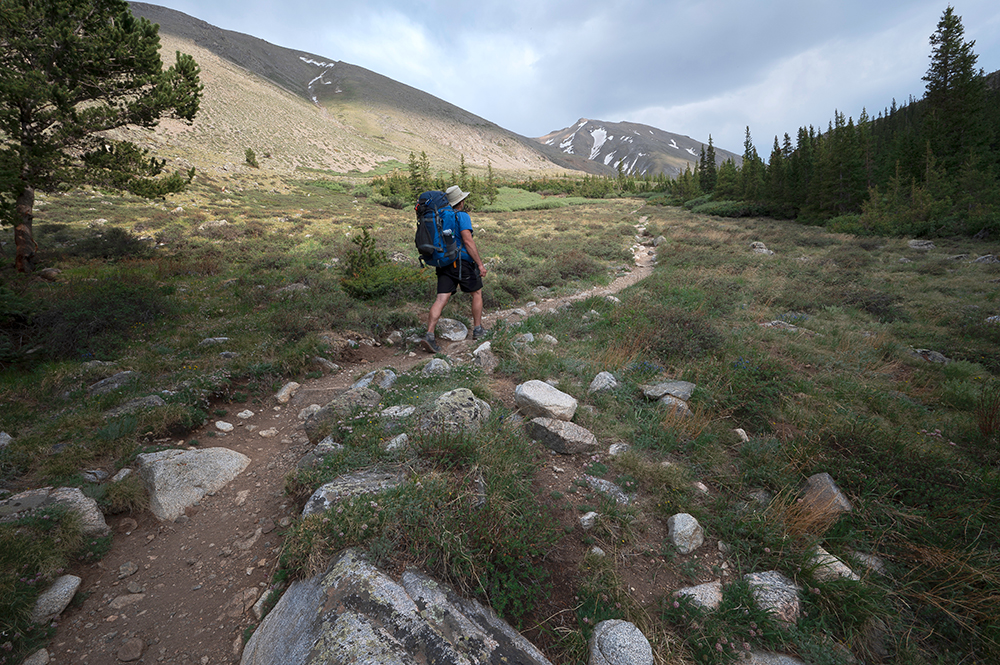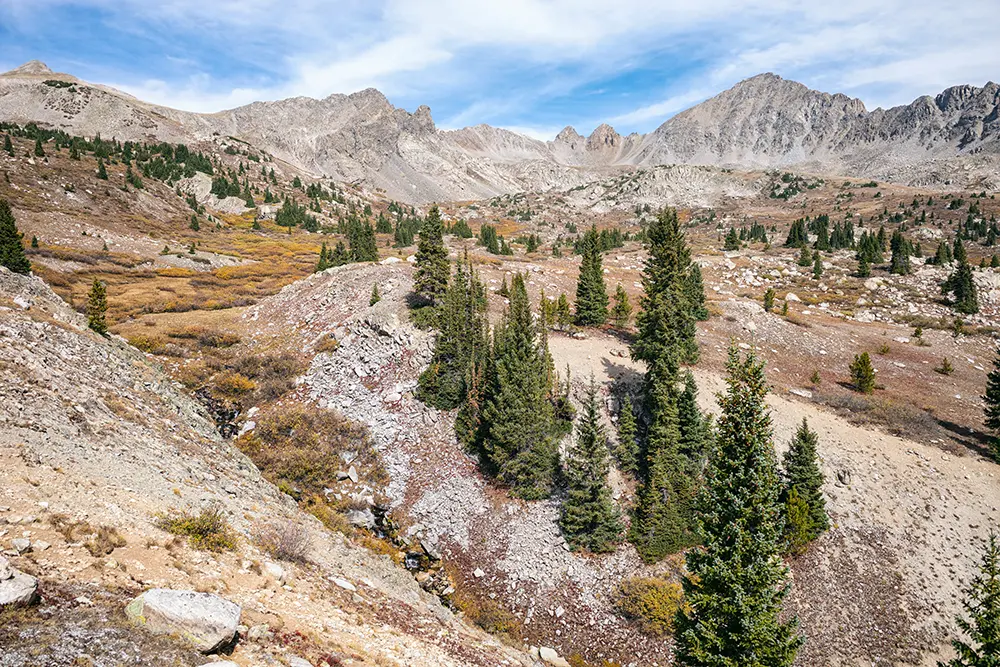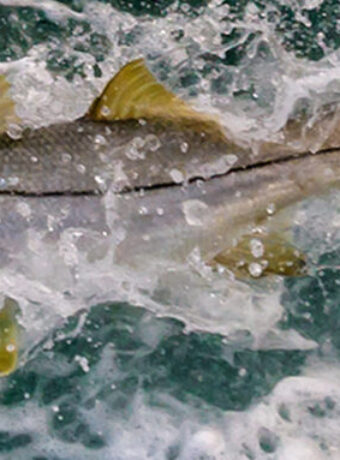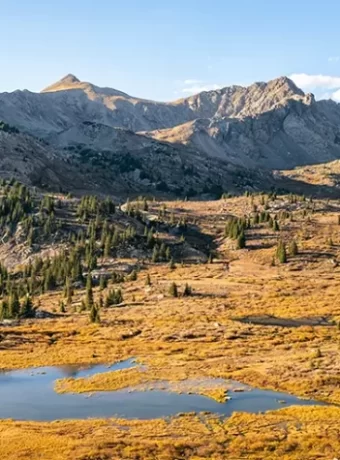61 Great Hikes: Explore the Stunning Collegiate Peaks Wilderness
Attention all you adventurous souls out there! If you’re craving a wild and rugged escape, Colorado’s Collegiate Peaks Wilderness is calling your name. With a whopping 61 trails to choose from, you’ll be spoiled for choice in this hiker’s wonderland. And trust me, the jaw-dropping views will leave you breathless (and not just because of the thin mountain air).
Years of wandering these trails have taught me that standing on a summit, surrounded by imposing peaks and unspoiled forests, is a truly unmatched experience. The Collegiate Peaks Wilderness caters to everyone, from veteran trekkers to beginners in search of a picturesque walk. Collegiate Peaks Wilderness to the north and south are some of my favorite hikes in the country. From north of Steamboat or south down through the Weminuche to the four corners. This is one of the most scenic stretches of the Rocky Mountains is the best in my opinion. I spent seven years hiking this area, Alpine nothing like it, just saying. Next to the Winds and Montana with over 30 years hiking, hunting and guiding from Glacier to Yellowstone. The Collegiate’s hold a special place in my heart.
Ready for an adventure? Tie those hiking boots tight, throw on your trusty backpack, and let’s conquer these trails as a team. Trust me, it’ll be an unforgettable journey.
Table Of Contents:
- 61 Best Hiking Trails in Collegiate Peaks Wilderness
- Exploring the Rugged Beauty of Collegiate Peaks Wilderness
- Essential Tips for Hiking in Collegiate Peaks Wilderness
- Accessing Collegiate Peaks Wilderness: Trailheads and Parking
- Hiking Trails Near Buena Vista and Salida
- Exploring the Colorado Trail in Collegiate Peaks Wilderness
- FAQs in Relation to Collegiate Peaks Wilderness 61 Great Hikes
- Conclusion Collegiate Peaks Wilderness 61 Great Hikes
- Alaskan Wilderness is Bigger & Better Fly Fishing
61 Best Hiking Trails in Collegiate Peaks Wilderness
The Collegiate Peaks Wilderness is a hiker’s paradise. With over 167,000 acres of pristine wilderness, this area offers some of the most stunning hiking trails in Colorado. From challenging 14er climbs to gentle walks through alpine meadows, there’s something for every level of hiker here. I’ve spent countless weekends exploring the Collegiate Peaks, and I’m always blown away by the rugged beauty of this place. The towering peaks, crystal-clear streams, and wildflower-filled valleys never fail to take my breath away. If you’re planning a trip to the Collegiate Peaks Wilderness, here are 61 of the best hiking trails to check out:
Horn Fork Basin Trail
The Horn Fork Basin Trail is a must-do for any hiker visiting the Collegiate Peaks Wilderness. This moderate 7.6-mile out-and-back trail takes you through a stunning alpine basin, with views of towering peaks like Mount Harvard and Mount Columbia. The trail starts at the Horn Fork Trailhead and climbs steadily through a dense forest of pine and aspen trees. As you gain elevation, the trees give way to open meadows filled with wildflowers in the summer months. The highlight of the hike is the stunning Horn Fork Basin, a high-alpine cirque surrounded by jagged peaks and dotted with small tarns. It’s the perfect spot for a picnic or a rest before heading back down the trail.

Fly Fishing on most of my Collegiate Peaks Wilderness excursions lead me to out of the way sections of tiny streams fly fishing a Prestige one weight to lakes casting a 11′ – 3 weight. I was always dressed in sun protective graphic hoodies, leggings and gloves. For comfortable days in the wilderness.
Hike to Lake Ann
Lake Ann Trail
If you’re looking for a shorter hike with big rewards, the Lake Ann Trail is a great option. This 3.6-mile out-and-back trail takes you to a stunning alpine lake nestled beneath the towering peaks of the Collegiate Peaks. The trail starts at the Lake Ann Trailhead and climbs steadily through a forest of pine and spruce trees. As you near the lake, the trees give way to open meadows filled with wildflowers in the summer months. Lake Ann itself is a stunning sight, with crystal-clear waters reflecting the surrounding peaks. It’s a popular spot for fishing, picnicking, and just soaking in the beauty of the Collegiate Peaks Wilderness. Truly a beautiful place to just be.
Kroenke Lake Trail
The Kroenke Lake Trail is another great option for hikers looking for a shorter trail with stunning views. This 4.2-mile out-and-back trail takes you to a beautiful alpine lake surrounded by towering peaks. The trail starts at the North Cottonwood Trailhead and climbs steadily through a dense forest of pine and spruce trees. As you near the lake, the trees give way to open meadows filled with wildflowers in the summer months. Kroenke Lake itself is a stunning sight, with crystal-clear waters and a backdrop of rugged peaks. It’s a great spot for a picnic or a refreshing swim on a hot summer day. A few to many weekend backpackers, if your very social, the place to be. I prefer solitude.
Browns Pass Trail
For a more challenging hike, the Browns Pass Trail is a great option. This 8.2-mile out-and-back trail takes you to a high mountain pass with stunning views of the surrounding peaks. The trail starts at the Browns Creek Trailhead and climbs steadily through a dense forest of pine and aspen trees. As you gain elevation, the trees give way to open meadows and rocky slopes. The highlight of the hike is Browns Pass itself, a high mountain saddle with panoramic views of the Collegiate Peaks. From here, you can see several 14ers, including Mount Belford, Mount Oxford, and Missouri Mountain.
Hartenstein Lake Trail
The Hartenstein Lake Trail is a challenging but rewarding hike that takes you to a stunning lake in Collegiate Peaks Wilderness. This 6.2-mile out-and-back trail starts at the Denny Creek Trailhead and climbs steadily through a dense forest of pine and spruce trees. As you gain elevation, the trees give way to open meadows and rocky slopes. The highlight of the hike is Hartenstein Lake itself, a stunning alpine lake surrounded by towering peaks and rocky cliffs. The lake is a popular spot for fishing and camping, with several designated campsites nearby. From the lake, you can also access several nearby peaks, including Mount Yale and Turner Peak.
Exploring the Rugged Beauty of Collegiate Peaks Wilderness
The Collegiate Peaks Wilderness is a true gem of the American West. Spanning over 167,000 acres across three national forests, this rugged wilderness area is home to some of the most stunning landscapes in Colorado. From towering 14,000-foot peaks to pristine alpine lakes and meadows, the Collegiate Peaks offer endless opportunities for adventure and exploration. One of the things that makes the Collegiate Peaks so special is the incredible diversity of landscapes within the wilderness area.
Diverse Landscapes
The Collegiate Peaks Wilderness is home to an incredible variety of landscapes, from dense forests of pine and aspen to open meadows filled with wildflowers. As you gain elevation, the landscape changes dramatically, with rocky slopes and alpine tundra dominating the higher elevations. One of the most stunning features of the Collegiate Peaks are the towering 14,000-foot peaks that give the wilderness its name. These massive mountains, including Mount Harvard, Mount Yale, and Mount Princeton, are a testament to the raw power and beauty of the natural world. Whether you’re climbing to the summit of one of these peaks or simply admiring them from afar, they’re sure to take your breath away.
Abundant Wildlife
In addition to its stunning landscapes, the Collegiate Peaks Wilderness is also home to an incredible variety of wildlife. From elk and deer to mountain goats and bighorn sheep, the wilderness is a haven for many of Colorado’s most iconic species. One of the best ways to spot wildlife in the Collegiate Peaks is to hike early in the morning or late in the evening, when animals are most active. Keep an eye out for tracks and scat on the trail, and don’t forget to bring a pair of binoculars to get a closer look at any animals you spot.
Challenging Terrain
While the Collegiate Peaks offer endless opportunities for adventure, it’s important to remember that this is a rugged and challenging wilderness area. Many of the trails in the Collegiate Peaks are steep and rocky, with significant elevation gains and losses. It’s important to come prepared with proper gear, including sturdy hiking boots, plenty of water, and warm layers for the unpredictable mountain weather. If you’re planning on tackling one of the more challenging trails in the Collegiate Peaks, such as the Browns Pass Trail or the Ptarmigan Lake Trail, it’s important to be in good physical condition and have experience with backcountry hiking.
Scenic Vistas Collegiate Peaks Wilderness 61 Great Hikes
One of the biggest draws of the Collegiate Peaks Wilderness is the incredible scenic vistas that can be found throughout the area. From the summit of a 14,000-foot peak to the shores of a pristine alpine lake, there are endless opportunities for breathtaking views in the Collegiate Peaks. Some of the most stunning vistas in the wilderness can be found along the Continental Divide, which runs through the heart of the Collegiate Peaks. Hikes like the Three Apostles Trail and the Continental Divide Trail offer incredible views of the surrounding peaks and valleys, as well as the opportunity to stand on the backbone of the continent as you explore Collegiate Peaks Wilderness 61 Great Hikes
Pristine Wilderness
Perhaps the most remarkable thing about the Collegiate Peaks is the sense of pristine wilderness that permeates the entire area. Despite its proximity to major cities like Denver and Colorado Springs, the Collegiate Peaks remain a largely untouched and unspoiled wilderness. This is thanks in large part to the efforts of conservationists and outdoor enthusiasts who have worked tirelessly to protect this incredible landscape for future generations. When you’re hiking in the Collegiate Peaks 61 great hikes, it’s easy to forget that you’re just a few hours’ drive from civilization. The rugged peaks, crystal-clear streams, and expansive meadows have a way of transporting you to another world entirely. It’s a reminder of the incredible power and beauty of the natural world, and the importance of preserving these wild places for generations to come.
Discover the Collegiate Peaks Wilderness, a hiker’s dream with over 167,000 acres of stunning trails. From easy walks to tough climbs, you’ll find your adventure among wildflowers and towering peaks. Check out trails like Horn Fork Basin for alpine beauty or Browns Pass for a challenge. Always come prepared for the rugged terrain.

Essential Tips for Hiking in Collegiate Peaks Wilderness 61 Great Hikes
If you’re planning a wilderness hiking adventure in the stunning Collegiate Peaks, there are a few essential things to keep in mind. First off, it’s crucial to plan your hike carefully. This means researching the trails, getting familiar with the area, and making sure you have the right gear.
Planning Your Hike
When it comes to planning your hike in the Collegiate Peaks Wilderness, the first step is to choose your route. With so many incredible trails to choose from, it can be tough to narrow it down. Personally, I’m a big fan of the Colorado Trail.
This iconic trail runs through the heart of the wilderness, offering stunning views of the surrounding peaks and valleys. Another great option is the Lake Ann Trail, which takes you to a beautiful alpine lake nestled beneath the towering peaks. Once you’ve chosen your route, it’s important to study the trail map and get familiar with the terrain. The National Geographic Collegiate Peaks Wilderness map is an excellent resource for this.
Packing Essentials
When it comes to packing for your hike, there are a few essential items you won’t want to forget. These include:
- Plenty of water and snacks
- A reliable hiking map and compass
- Warm layers and rain gear
- Sun protection (hat, sunglasses, sunscreen)
- First aid kit
- Headlamp or flashlight
I can’t stress enough how important it is to have a good hiking map. The wilderness series maps from National Geographic are my go-to. They’re detailed, durable, and easy to read.
Navigation and Maps
Speaking of maps, let’s talk about navigation. While the trails in the Collegiate Peaks Wilderness are generally well-marked, it’s still important to know how to navigate with a map and compass. Before you head out, take some time to study your route on the map. Pay attention to key landmarks, trail junctions, and potential bailout points. On the trail, keep your map and compass handy and refer to them often. Don’t rely solely on trail signs or your phone’s GPS. Trust me, there’s nothing quite like the feeling of confidently navigating through the wilderness with just a map and compass. It’s a skill that every hiker should learn.
Weather Considerations
One thing to keep in mind when hiking in the Collegiate Peaks Wilderness is that the weather can change quickly and dramatically. Even in the summer months, it’s not uncommon for afternoon thunderstorms to roll in, bringing lightning, heavy rain, and even hail. That’s why it’s so important to start your hike early in the day and keep a close eye on the weather. If you see dark clouds building or hear thunder in the distance, it’s time to turn around and head back to the trailhead. I’ve had a few close calls with lightning over the years, and let me tell you, it’s not something you want to mess around with. Always err on the side of caution when it comes to mountain weather.
Leave No Trace Principles
Finally, no discussion of wilderness hiking would be complete without mentioning Leave No Trace principles. These guidelines help us minimize our impact on the environment and preserve the wilderness for future generations. They include things like:
- Packing out all trash and waste
- Staying on designated trails
- Camping at least 200 feet from water sources
- Minimizing campfire impacts
- Respecting wildlife
As hikers, we have a responsibility to be good stewards of the land. By following Leave No Trace principles, we can help ensure that the Collegiate Peaks Wilderness remains a pristine and beautiful place for years to come.
Accessing Collegiate Peaks Wilderness: Trailheads and Parking
One of the great things about the Collegiate Peaks Wilderness is how accessible it is. With numerous trailheads and parking areas scattered throughout the region, it’s easy to find a starting point for your adventure. That said, some trailheads are more popular than others, and parking can be limited, especially on weekends and holidays. Here’s a rundown of some of the main access points:
Denny Creek Trailhead
The Denny Creek Trailhead is one of the most popular starting points for hikes in the Collegiate Peaks Wilderness. Located just off the road between Buena Vista and Leadville, this trailhead provides access to a number of excellent trails, including the Mount Yale Trail and the Denny Creek Trail. Parking at the Denny Creek Trailhead can fill up quickly, especially on summer weekends. I recommend arriving early in the morning to secure a spot.
Cottonwood Pass Trailhead
Another popular access point is the Cottonwood Pass Trailhead, located at the top of Cottonwood Pass between Buena Vista and Crested Butte. This trailhead provides access to the stunning Colorado Trail and Continental Divide Trail. On the way to Cotton Pass you pass Ptarmigan Lake Trail, as well as a number of other high-country trails such as Lost Lake.. Keep in mind that the road to Cottonwood Pass is paved and extremely beautiful drive.
North Cottonwood Creek Trailhead
If you’re looking to escape the crowds, the North Cottonwood Creek Trailhead is a great option. Located in a remote corner of the wilderness near the town of Granite, this trailhead provides access to a number of less-traveled trails, including the North Cottonwood Trail and the Texas Creek Trail. The road to the North Cottonwood Creek Trailhead is rough and narrow in spots, so take it slow and watch for oncoming traffic.
Avalanche Trailhead
For those looking to explore the southern end of the wilderness, the Avalanche Trailhead is a great starting point. Located near the town of Saguache, this trailhead provides access to the rugged and remote Cottonwood Creek Trail. Be aware that the road to the Avalanche Trailhead is long and rough, with several stream crossings.
Sheep Gulch Trailhead
Finally, the Sheep Gulch Trailhead is a great option for those looking to explore the eastern side of the wilderness. Located near the town of Salida, this trailhead provides access to a number of excellent trails, including the Pine Creek Trail and the Little Sheep Mountain Trail. Parking at the Sheep Gulch Trailhead is limited, so arrive early to secure a spot. No matter which trailhead you choose, remember to always practice Leave No Trace principles and be prepared for changing weather conditions. With a little planning and preparation, you’re sure to have an unforgettable adventure in the Collegiate Peaks Wilderness.
Planning your Collegiate Peaks hike? Start by picking a trail, like the Colorado Trail or Lake Ann. Don’t forget essentials: water, snacks, map, compass, layers, and sun protection. Always check the weather; afternoon storms are common. Respect Leave No Trace principles to keep it pristine for others. Choose from several accessible trailheads but arrive early for parking.
Hiking Trails Near Buena Vista and Salida
If you’re looking for some of the best hiking in the Collegiate Peaks Wilderness, you’ve got to check out the trails near Buena Vista and Salida. These two towns sit right at the base of the Sawatch Range, giving you easy access to some of the most stunning 14ers in Colorado.
Mount Yale Trail
First up, the Mount Yale Trail. This challenging hike takes you to the summit of Mount Yale, one of the iconic 14ers in the Collegiate Peaks. The trail starts near Buena Vista and climbs steadily through forests and alpine meadows before reaching the rocky summit. At 14,196 feet, the views from the top are absolutely breathtaking. You can see for miles in every direction, with the Sawatch Range stretching out before you and the Arkansas River Valley far below.

Backpacking the Colorado Trail through the Collegiate Peaks Wilderness: A 3-Day Adventure
Tucked away in the heart of Colorado’s Sawatch Range, the Collegiate Peaks Wilderness Area offers a backpacker’s dream: towering peaks, serene alpine lakes, and miles of pristine trails. Spanning over 168,000 acres, this wilderness area is named after its iconic Colorado fourteeners—mountains over 14,000 feet—like Mount Harvard, Mount Yale, and Mount Princeton, which were christened in honor of Ivy League universities. The Colorado Trail and Continental Divide Trail both traverse this rugged landscape, providing hikers with a perfect blend of challenge and beauty. Whether you’re seeking solitude, adventure, or a chance to summit some of Colorado’s highest peaks, backpacking in the Collegiate Peaks promises an unforgettable journey. This 1500-word guide details a 3-day backpacking trip along the Colorado Trail through this stunning wilderness, complete with trail highlights, preparation tips, and practical advice for your Colorado hiking adventure.
Overview of the Colorado Trail in the Collegiate Peaks Wilderness
The Colorado Trail through the Collegiate Peaks Wilderness covers approximately 25 miles of diverse terrain, ranging from dense forests to high-altitude passes. With elevations between 8,000 and 12,000 feet, this section offers moderate to strenuous hiking, depending on your pace and experience. The trail winds through aspen groves, pine forests, and open meadows bursting with wildflowers in the summer, while offering breathtaking views of the surrounding peaks. Key highlights include the shimmering Twin Lakes, the serene Harvard Lakes, and the panoramic vistas from Cottonwood Pass. This stretch of the Colorado Trail is ideal for a 3-day backpacking trip, providing a balance of challenge and accessibility for both seasoned hikers and those new to multi-day adventures.
The best time to hike is from July to September, when snow has melted from the higher elevations and the weather is generally stable—though afternoon thunderstorms remain a possibility. Whether you’re aiming to complete a segment of the Colorado Trail or simply seeking a weekend escape into the wilderness, this trip offers a quintessential Rocky Mountain hiking experience.
Detailed Trail Description: A 3-Day Itinerary
For a north-to-south backpacking trip starting at Twin Lakes and ending at Cottonwood Pass, a 3-day itinerary is perfect. Below is a day-by-day breakdown of this hiking the Colorado Trail adventure, including distances, elevation changes, and notable features.
Day 1: Twin Lakes to Harvard Lakes
-
Distance: ~8 miles
-
Elevation Gain: 1,200 feet
-
Description: Your journey begins at the Twin Lakes Trailhead, where the shimmering waters of Twin Lakes reflect the surrounding peaks. The trail starts gently, winding through aspen and pine forests, with occasional meadows offering glimpses of the rugged Sawatch Range. As you hike, the sound of rustling leaves and distant streams creates a soothing backdrop. After about 8 miles, you’ll reach Harvard Lakes, a pair of small alpine lakes nestled in a quiet basin. These serene lakes are an ideal spot to set up camp, with plenty of flat areas for tents and easy access to water (remember to filter it). As the sun sets, the peaks glow in the alpenglow, setting the stage for a peaceful night under the stars.
Day 2: Harvard Lakes to Texas Creek
-
Distance: ~9 miles
-
Elevation Gain: 1,500 feet
-
Description: Day two takes you deeper into the wilderness, with the trail climbing steadily through dense forests and crossing several small streams. Keep an eye out for wildlife—mule deer, elk, and even black bears call this area home. The path opens up to expansive meadows, where wildflowers bloom in vibrant colors during the summer months. After about 9 miles, you’ll arrive at Texas Creek, a reliable water source and a popular camping spot. The creek’s gentle flow provides a calming ambiance, and the surrounding trees offer shelter from the wind. Set up camp here and enjoy the solitude of the wilderness, far from the hustle of everyday life.
Day 3: Texas Creek to Cottonwood Pass
-
Distance: ~8 miles
-
Elevation Gain: 2,000 feet
-
Description: The final day begins with a steady climb toward Cottonwood Pass (12,126 feet), the highest point of this trip. As you ascend, the trees thin out, revealing sweeping views of the Collegiate Peaks and the vast Arkansas Valley below. The trail can be steep in sections, but the reward is worth the effort. Upon reaching the pass, you’ll be greeted by panoramic vistas of snow-capped peaks and rolling hills stretching to the horizon. Take a moment to soak in the beauty before beginning your descent. If you’ve arranged a shuttle or have a second vehicle, you can conclude your hike here. Otherwise, you can retrace your steps or explore nearby trails for additional adventures.
Optional Side Trips: Summiting Colorado Fourteeners
For those seeking an extra challenge, the Collegiate Peaks Wilderness offers access to several Colorado fourteeners. From the Colorado Trail, you can detour to summit peaks like Mount Yale (14,196 feet) or Mount Columbia (14,073 feet). These side trips require additional time and energy, so plan accordingly.
-
Mount Yale: Accessible from the Avalanche Trailhead near Cottonwood Pass, the hike to the summit is approximately 9.5 miles round-trip with 4,300 feet of elevation gain. The trail is steep but well-marked, offering stunning views from the top.
-
Mount Columbia: From the North Cottonwood Trailhead, the summit hike is about 11 miles round-trip with 4,500 feet of elevation gain. The trail is less traveled and can be challenging, but the solitude and vistas are unparalleled.
If you choose to summit, consider adding an extra day to your itinerary to allow for rest and recovery.
Planning and Preparation for Your Colorado Trail Backpacking Trip
Proper preparation is essential for a safe and enjoyable backpacking in Colorado experience. Here’s everything you need to know to plan your trip through the Collegiate Peaks Wilderness.
Permits and Regulations
-
Wilderness Permits: A free, self-issued permit is required at the trailhead. These can be obtained at kiosks located at major entry points.
-
Camping Rules: Dispersed camping is allowed, but you must camp at least 100 feet from water sources and trails. Follow Leave No Trace principles to minimize your impact on the environment.
-
Fire Restrictions: Campfires may be prohibited during dry seasons, so check current regulations and consider using a camp stove instead.
Essential Gear
To handle the variable conditions of the Colorado Trail, pack the following:
-
Lightweight backpack with rain cover
-
Tent rated for wind and rain
-
Sleeping bag suitable for temperatures down to 20°F
-
Layered clothing (including a waterproof jacket and warm layers)
-
Sturdy hiking boots with ankle support
-
Trekking poles for stability on steep sections
-
Water filter or purification tablets
-
Bear canister or bear bag for food storage
-
Map, compass, and GPS device (cell service is unreliable)
-
First aid kit with blister treatment and altitude sickness medication
Food and Water
-
Water Sources: Streams and lakes are plentiful along the trail, but always treat water with a filter or purification tablets to avoid giardia or other contaminants.
-
Food Storage: Plan lightweight, high-calorie meals and store them securely to deter wildlife. A bear canister is recommended, especially in areas with known bear activity.
Safety Considerations
-
Altitude Acclimatization: With elevations ranging from 8,000 to 12,000 feet, spend a day or two at a lower altitude before starting to avoid altitude sickness. Stay hydrated and monitor your body for symptoms like headaches or nausea.
-
Weather: Check forecasts and prepare for sudden storms, snow, or high winds—even in summer. Carry a whistle or signaling device for emergencies.
-
Navigation: The Colorado Trail is well-marked, but a detailed map and GPS are essential in this remote area.
Why Backpack the Colorado Trail in the Collegiate Peaks Wilderness?
The Collegiate Peaks Wilderness offers a unique combination of accessibility and rugged beauty. The Colorado Trail provides a well-maintained path through some of the state’s most stunning landscapes, from lush forests to high-altitude passes. Along the way, you’ll encounter vibrant wildflowers, crystal-clear streams, and the chance to spot wildlife in their natural habitat. The area’s rich history—once home to the Ute people and later a hub for mining—adds a layer of cultural significance to your journey.
For those seeking a challenge, the option to summit nearby fourteeners like Mount Yale or Mount Columbia adds an extra dimension to the trip. Whether you’re a seasoned backpacker or new to multi-day hikes, this section of the Colorado Trail offers a perfect blend of adventure and tranquility.
Best Time to Hike
The ideal window for hiking the Colorado Trail in the Collegiate Peaks Wilderness is from July to September. During this period, snow has typically melted from the higher elevations, and the weather is more predictable. July and August bring vibrant wildflowers, while September offers stunning fall colors as the aspens turn golden. However, be prepared for afternoon thunderstorms, which are common in the summer months. Snow can linger into July at higher elevations, so check trail conditions before setting out.
Nearby Services and Amenities
Before or after your trip, nearby towns like Buena Vista and Leadville offer a range of services for hikers:
-
Lodging: Hotels, motels, and campgrounds are available in both towns.
-
Resupply: Grocery stores and outdoor gear shops can be found in Buena Vista and Leadville.
-
Dining: Enjoy a post-hike meal at local restaurants, many of which cater to outdoor enthusiasts.
Both towns are within a short drive of the trailheads, making them convenient bases for your adventure.
Conclusion
The Colorado Trail through the Collegiate Peaks Wilderness is more than just a hike—it’s an immersion into the heart of Colorado’s most breathtaking landscapes. From the shimmering waters of Twin Lakes to the panoramic views at Cottonwood Pass, every step of this journey reveals the raw beauty of the Rocky Mountains. Whether you’re drawn by the challenge of high-altitude hiking, the allure of Colorado fourteeners, or the simple joy of camping under the stars, this trail delivers an experience that will stay with you long after you’ve returned home. So pack your gear, secure your wilderness permits, and set out on an adventure that blends rugged wilderness with the serenity of nature. The Collegiate Peaks Wilderness awaits—ready to inspire and challenge you in equal measure.
Missouri Mountain Trail
Next on the list is the Missouri Mountain Trail, another classic 14er hike in the Collegiate Peaks Wilderness. This trail, which starts near the small town of Vicksburg, is known for its steep and rocky terrain. But trust me, the views are worth the effort. As you climb higher and higher, you’ll pass through dense forests and cross several small streams before emerging above treeline. From there, it’s a challenging scramble to the summit of Missouri Mountain at 14,067 feet.
Mount Harvard Trail
If you’re up for an even bigger adventure, consider tackling the Mount Harvard Trail. At 14,420 feet, Mount Harvard is the third-highest peak in the Collegiate Peaks and the fourth-highest in all of Colorado. The trail to the summit is long and strenuous, with over 4,600 feet of elevation gain. But the views from the top are simply unparalleled. You’ll have a panoramic vista of the Sawatch Range, with Mount Yale, Mount Princeton, and Mount Antero all visible in the distance. It’s an incredible sight that will take your breath away (if the thin air at 14,000 feet hasn’t already done that.).
Mount Columbia Trail
For a slightly less crowded 14er experience, check out the Mount Columbia Trail. This hike starts near the ghost town of Vicksburg and climbs steeply through the forest before reaching the alpine zone. From there, you’ll follow a rocky ridge to the summit of Mount Columbia at 14,073 feet. The views from the top stretch from the Elk Mountains in the west to the Mosquito Range in the east, with the Sawatch Range dominating the skyline to the north.
Mount Oxford Trail
Last but not least is the Mount Oxford Trail, which offers a challenging but rewarding hike to the summit of this 14,153-foot peak. The trail starts near the Missouri Gulch trailhead and climbs steeply through the forest before reaching the ridge between Mount Oxford and Mount Belford. From there, it’s a rocky scramble to the summit, with jaw-dropping views in every direction. On a clear day, you can see all the way to the San Juan Mountains in the southwest and the Front Range in the northeast. It’s an incredible panorama that showcases the rugged beauty of the Collegiate Peaks Wilderness. So there you have it – five of the best hiking trails near Buena Vista and Salida, all of which offer access to some of the most stunning 14ers in Colorado. Whether you’re a seasoned peak-bagger or a first-time 14er hiker, these trails are sure to take your breath away (in more ways than one.). Just remember to come prepared with plenty of water, snacks, and warm layers – the weather can change quickly at high elevations, and it’s always better to be overprepared than underprepared. And don’t forget your camera – trust me, you’re going to want to document these views.
Exploring the Colorado Trail in Collegiate Peaks Wilderness and Beyond
If you’re looking for a longer backpacking adventure in the Collegiate Peaks Wilderness, the Colorado Trail is the perfect option. This iconic long-distance trail stretches 486 miles from Denver to Durango, passing through some of the most stunning scenery in the state along the way. And lucky for us, a good chunk of it runs right through the heart of the Collegiate Peaks.
Segment 11: Twin Lakes to Clear Creek Road
Segment 11 of the Colorado Trail starts at the Twin Lakes trailhead and winds its way through the San Isabel National Forest before reaching Clear Creek Road. This section is known for its stunning views of the Sawatch Range, with several 14ers visible along the way. You’ll pass through dense forests and cross several small streams as you make your way through the wilderness. One of the highlights of this segment is the chance to take a short detour to the top of Mount Elbert, the highest peak in Colorado at 14,439 feet. The views from the summit are simply incredible, with the Collegiate Peaks stretching out before you in every direction.
Segment 12: Clear Creek Road to Silver Creek
Segment 12 of the Colorado Trail picks up where Segment 11 leaves off, at Clear Creek Road. From there, the trail climbs steeply through the forest before emerging above treeline in the alpine zone. This section is known for its challenging terrain, with several steep and rocky sections that will test your endurance. But the views are more than worth it, with the Collegiate Peaks towering above you on all sides. As you make your way along the trail, you’ll pass by several high alpine lakes and cross the Continental Divide at Cottonwood Pass. It’s a stunning section of the trail that showcases the rugged beauty of the Collegiate Peaks Wilderness.
Segment 13: Silver Creek to Chalk Creek Pass
Segment 13 of the Colorado Trail is a bit of a roller coaster, with several steep climbs and descents as you make your way through the San Isabel National Forest. This section starts at Silver Creek and winds its way along the flanks of several high peaks before reaching Chalk Creek Pass. As well as Upper and Lower Hancock Lakes. Good Fly Fishing. Along the way, you’ll pass through dense forests and cross several small streams, with stunning views of the Collegiate Peaks at every turn. One of the highlights of this segment is the chance to take a short detour to the top of Mount Princeton, one of the most iconic 14ers in the Sawatch Range. The views from the summit are simply breathtaking, with the Arkansas River Valley stretching out below you and the Collegiate Peaks towering above.
Segment 14: Chalk Creek Pass to US 50
The final segment of the Colorado Trail in the Collegiate Peaks Wilderness is Segment 14, which runs from Chalk Creek Pass to US 50 near the town of Salida. This section is known for its stunning views of the Arkansas River Valley, with several high points along the way that offer panoramic vistas of the surrounding mountains. You’ll pass through dense forests and cross several small streams as you make your way along the trail. One of the highlights of this segment is the chance to take a short detour to the top of Mount Shavano, another iconic 14er in the Sawatch Range. The views from the summit are simply incredible, with the Collegiate Peaks stretching out before you in every direction. As you make your way along the trail, you’ll also pass by several historic sites, including the remnants of old mining camps and homesteads. It’s a fascinating glimpse into the rich history of this rugged and beautiful wilderness area. So there you have it – a brief overview of the Colorado Trail as it passes through the Collegiate Peaks Wilderness. Whether you’re a seasoned thru-hiker or just looking for a scenic section to explore over a weekend, this trail has something for everyone. Just remember to come prepared with plenty of water, food, and warm layers – the weather can change quickly at high elevations, and it’s always better to be overprepared than underprepared. And don’t forget your camera – trust me, you’re going to want to document these incredible views.
Hit the trails near Buena Vista and Salida for some of Colorado’s most breathtaking hikes. Tackle iconic 14ers like Mount Yale and Missouri Mountain, each offering unique challenges and rewards. For a longer journey, dive into the Colorado Trail segments that wind through stunning Collegiate Peaks scenery. Remember to pack plenty of supplies and your camera—you won’t want to miss these views.
FAQs in Relation to Collegiate Peaks Wilderness 61 Great Hikes
How long is the collegiate peaks loop?
The Collegiate Peaks Loop spans roughly 160 miles, winding through some of Colorado’s most stunning landscapes.
What is the easiest trail to Mt Elbert?
The East Ridge route offers the gentlest ascent to Mt. Elbert’s summit, suitable for most hikers.
How many peaks are in the collegiate peaks?
In total, there are fifteen named mountains in the Collegiate Peaks Wilderness soaring above 14,000 feet.
What is the highest elevation hike in Colorado?
Mt. Elbert stands as Colorado’s loftiest hike at 14,439 feet above sea level – a sky-high challenge. Another cool hike.
Conclusion Collegiate Peaks Wilderness 61 Great Hikes
Wow, what a journey through the Collegiate Peaks Wilderness! We’ve explored lush forests, climbed rugged peaks, and discovered hidden alpine lakes. These 61 great hikes showcase the incredible diversity and beauty of this stunning wilderness area.
But let’s be real: a hike in the Collegiate Peaks Wilderness is about way more than the endpoint. We’re talking about the whole enchilada – the physical test, the mental game, and that deep, soulful connection with Mother Nature herself. Whether you’re going all out on a beast of a trail or just vibing on a chill walk, every single path has got its own unique magic, just waiting for you to come and get it.
Why wait another second? The Collegiate Peaks Wilderness is calling your name, with 61 incredible hiking trails just begging to be explored. Lace up those boots and hit the trails – your entire being will be grateful for the adventure.
Alaskan Wilderness is Bigger & Better Fly Fishing
Head to the great white north for another adventure you will never forget.






